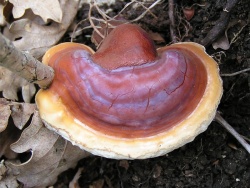Difference between revisions of "Lingzhi 靈芝 ''magic mushroom''"
Jump to navigation
Jump to search
(Created page with "thumb|250px| The lingzhi 靈芝 is a fabulous magic mushroom. It is also called sanxiu 三秀 and is first mentioned in Cao Zhi's ...") |
|||
| Line 1: | Line 1: | ||
[[File:Lingzhi_靈芝_magic_mushroom.jpg|thumb|250px|]] | [[File:Lingzhi_靈芝_magic_mushroom.jpg|thumb|250px|]] | ||
| − | The lingzhi 靈芝 is a fabulous magic mushroom. It is also called sanxiu 三秀 and is first mentioned in Cao Zhi's 曹植 poem Lingzhi pian 靈芝篇 from the Wei period 曹魏 (220-265). Zhang Heng 張恆 from the Han period 漢 (206 BCE-220 CE) called it lingcao 靈草 "magic herb". It is a red plant that, if consumed, rendered eternal youth or was even able to revive deceased persons. The emperors of China therefore used a "scepter" in the imaginary shape of a lingzhi mushroom which was called ruyi 如意 "fulfilment of wishes". | + | The [[lingzhi]] 靈芝 is a fabulous [[magic]] mushroom. It is also called sanxiu 三秀 and is first mentioned in Cao Zhi's 曹植 poem [[Lingzhi]] pian 靈芝篇 from the Wei period 曹魏 (220-265). Zhang Heng 張恆 from the Han period 漢 (206 BCE-220 CE) called it lingcao 靈草 "[[magic]] herb". It is a red [[plant]] that, if consumed, rendered [[eternal]] youth or was even able to revive deceased persons. The {{Wiki|emperors}} of [[China]] therefore used a "scepter" in the [[imaginary]] [[shape]] of a [[lingzhi]] mushroom which was called ruyi 如意 "fulfilment of wishes". |
'''Source''': | '''Source''': | ||
Latest revision as of 14:50, 17 September 2013
The lingzhi 靈芝 is a fabulous magic mushroom. It is also called sanxiu 三秀 and is first mentioned in Cao Zhi's 曹植 poem Lingzhi pian 靈芝篇 from the Wei period 曹魏 (220-265). Zhang Heng 張恆 from the Han period 漢 (206 BCE-220 CE) called it lingcao 靈草 "magic herb". It is a red plant that, if consumed, rendered eternal youth or was even able to revive deceased persons. The emperors of China therefore used a "scepter" in the imaginary shape of a lingzhi mushroom which was called ruyi 如意 "fulfilment of wishes".
Source:
- Yuan Ke 袁珂 (ed. 1985). Zhongguo shenhua chuanshuo cidian 中國神話傳說詞典, p. 217. Shanghai: Shanghai cishu chubanshe.
